

Quantum Statistics Concepts. Dynamics of a System of Ultracold Potassium Atoms. Figure 1: A system of fermionic atoms in an optical lattice (top) is brought out of equilibrium and exhibits different dynamics for non-interacting (left) and interacting atoms (right).
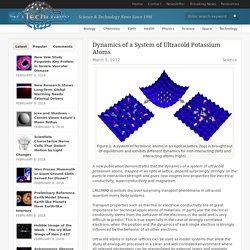
A new publication demonstrates that the dynamics of a system of ultracold potassium atoms, trapped in an optical lattice, depend surprisingly strongly on the particle interaction strength and gives new insights into properties like electrical conductivity, superconductivity and magnetism. LMU/MPQ-scientists discover surprising transport phenomena in ultracold quantum many body systems. Transport properties such as thermal or electrical conductivity are of great importance for technical applications of materials. In particular the electrical conductivity stems from the behavior of the electrons in the solid and is very difficult to predict. So-called optical lattices are generated by superimposing several laser beams. Surprisingly, only the magnitude, but not the sign of the interaction matters. Wightman axioms. In physics the Wightman axioms are an attempt at a mathematically rigorous formulation of quantum field theory.
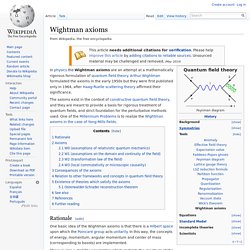
Schwinger function. Be the reflected point about the τ = 0 hyperplane.

Then, where * represents complex conjugation. The Osterwalder–Schrader theorem states that Schwinger functions which satisfy these properties can be analytically continued into a quantum field theory. Then, Since the action S is real and can be split into S+ which only depends on φ on the positive half-space and S− which only depends upon φ on the negative half-space, if S also happens to be invariant under the combined action of taking a reflection and complex conjugating all the fields, then the previous quantity has to be nonnegative.
On the stochastic quantization of field theory. Rabi frequency. The Rabi frequency is the frequency of oscillation for a given atomic transition in a given light field.It also gives the measure of the fluctuation of population between the levels.

It is associated with the strength of the coupling between the light and the transition. Rabi flopping between the levels of a 2-level system illuminated with resonant light, will occur at the Rabi frequency. The Rabi frequency is a semiclassical concept as it is based on a quantum atomic transition and a classical light field. In the context of a nuclear magnetic resonance experiment, the Rabi frequency is the nutation frequency of a sample's net nuclear magnetization vector about a radiofrequency field.
(Note that this is distinct from the Larmor frequency, which characterizes the precession of a transverse nuclear magnetization about a static magnetic field.) Spontaneous emission. Spontaneous emission is the process by which a quantum system such as an atom, molecule, nanocrystal or nucleus in an excited state undergoes a transition to a state with a lower energy (e.g., the ground state) and emits quanta of energy.
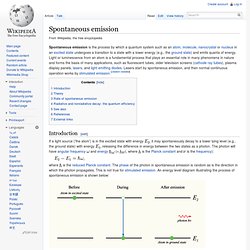
Quantum Monte Carlo. Quantum Monte Carlo is a large class of computer algorithms that simulate quantum systems with the idea of solving the quantum many-body problem.

They use, in one way or another, the Monte Carlo method to handle the many-dimensional integrals that arise. Quantum Monte Carlo allows a direct representation of many-body effects in the wave function, at the cost of statistical uncertainty that can be reduced with more simulation time. For bosons without frustration, there exist numerically exact and polynomial-scaling algorithms. For fermions, there exist very good approximations and numerically exact exponentially scaling quantum Monte Carlo algorithms, but none that are both. Background[edit] In principle, any physical system can be described by the many-body Schrödinger equation as long as the constituent particles are not moving "too" fast; that is, they are not moving near the speed of light.
Quantum annealing. Quantum annealing (QA) is a general method for finding the global minimum of a given objective function over a given set of candidate solutions (candidate states), by a process using quantum fluctuations.[1][2] It is used mainly for problems where the search space is discrete (combinatorial optimization problems) with many local minima; such as finding the ground state of a spin glass employing quantum tunneling [3] (across the barriers separating the global minimum from the local minima or spin configurations).
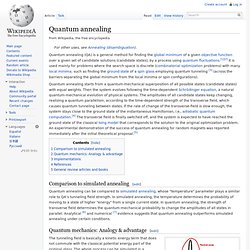
Quanten-Hall-Effekt. Der Quanten-Hall-Effekt (kurz: QHE) äußert sich dadurch, dass bei tiefen Temperaturen und starken Magnetfeldern die senkrecht zu einem Strom auftretende Spannung nicht wie beim klassischen Hall-Effekt linear mit dem Magnetfeld anwächst, sondern in Stufen.

Der Effekt tritt an Grenzflächen auf, bei denen die Elektronen als zweidimensionales Elektronengas beschrieben werden können. Der sog. Hall-Widerstand RH, also das Verhältnis der Hall-Spannung zur Stromstärke, nimmt dabei als Plateauwerte nur ganzzahlige Bruchteile der sehr genau bekannten Größe an ( ), wobei h das plancksche Wirkungsquantum und e die Elementarladung ist. Infrarotproblem. Das Infrarotproblem der Quantenelektrodynamik ist ein Problem der Quantenfeldtheorie.
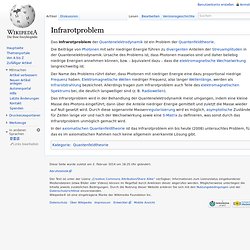
Die Beiträge von Photonen mit sehr niedriger Energie führen zu divergenten Anteilen der Streuamplituden in der Quantenelektrodynamik. Ursache des Problems ist, dass Photonen masselos sind und daher beliebig niedrige Energien annehmen können, bzw. – äquivalent dazu – dass die elektromagnetische Wechselwirkung langreichweitig ist. Der Name des Problems rührt daher, dass Photonen mit niedriger Energie eine dazu proportional niedrige Frequenz haben. Elektromagnetische Wellen niedriger Frequenz, also langer Wellenlänge, werden als Infrarotstrahlung bezeichnet. Quantum Entanglement. Quanten-Zeno-Effekt. Der Quanten-Zeno-Effekt ist ein Effekt aus der Quantenmechanik, bei dem der Übergang eines quantenmechanischen Systems von einem Zustand in einen anderen, z.
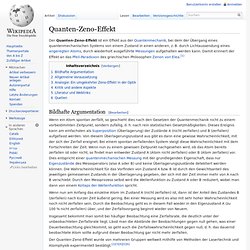
B. durch Lichtaussendung eines angeregten Atoms, durch wiederholt ausgeführte Messungen aufgehalten werden kann. Damit erinnert der Effekt an das Pfeil-Paradoxon des griechischen Philosophen Zenon von Elea.[1] Bildhafte Argumentation[Bearbeiten] Wenn nun am Anfang das einzelne Atom im Zustand A (nicht zerfallen) ist, dann ist der Anteil des Zustandes B (zerfallen) nach kurzer Zeit äußerst gering. Quantum entanglement. Quantum entanglement is a physical phenomenon that occurs when pairs or groups of particles are generated or interact in ways such that the quantum state of each particle cannot be described independently – instead, a quantum state may be given for the system as a whole.
Lindblad equation. In quantum mechanics, Kossakowski–Lindblad equation (after Andrzej Kossakowski and Göran Lindblad) or master equation in Lindblad form is the most general type of Markovian and time-homogeneous master equation describing non-unitary evolution of the density matrix that is trace-preserving and completely positive for any initial condition. Batalin–Vilkovisky formalism.
Augerelektronenspektroskopie. Die Augerelektronenspektroskopie [oʒe-] (AES, nach Pierre Auger) ist eine spektroskopische Methode zur hochempfindlichen und zerstörungsfreien Untersuchung der chemischen Zusammensetzung einer Materialoberfläche. Sie beruht auf dem Auger-Effekt, durch den ein Atom, das in geeigneter Weise angeregt wurde, ein Elektron mit einer bestimmten, je nach chemischem Element verschiedenen kinetische Energie aussendet.
Rabi-Oszillation. Schematische Darstellung eines Zweizustandssystems, das mit elektromagnetischer Strahlung wechselwirkt. Rabi-Oszillationen treten in einem quantenmechanischen Zwei-Niveau-System (z. B. zwei Zustände in einem Atom) auf, welches mit einer externen periodischen Kraft (z. Fermis Goldene Regel. Formel[Bearbeiten] Wird ein Anfangszustand einer Störung ausgesetzt, durch die er in einen Endzustand gegeben. Störungstheorie (Quantenmechanik) Die Störungstheorie ist eine wichtige Methode der theoretischen Physik, die Auswirkungen einer zeitunabhängigen Störung auf ein analytisch lösbares System untersucht. Vor der Erfindung des Computers war es nur durch solche Methoden möglich, Näherungslösungen für analytisch nicht geschlossen lösbare Probleme zu finden.
Kohärenzlänge. Zum Verständnis ist es wichtig sich klarzumachen, dass in diesem Zusammenhang insbesondere reale, nicht idealisierte Lichtquellen betrachtet werden. Für diese gilt, dass sie nicht absolut monochromatische Lichtwellen aussenden, die eine zeitlich konstante Polarisations- und Phasenbeziehung zueinander haben. Bei absolut monochromatischem Licht wäre die Kohärenzlänge unendlich. Laser erzeugen Licht mit einer großen bis sehr großen Kohärenzlänge (bis zu vielen Kilometern). Auf natürliches Licht (Sonnenlicht, Flamme, Wärmestrahlung etc.) ist der Begriff kaum anwendbar, eine Kohärenzlänge läge hier im Bereich der mittleren Wellenlänge (Größenordnung 10-6m).
Hier zeigen sich sichtbare Interferenzmuster nur an schlanken Lichtbündeln, die Kohärenzlängen erreichen einige Meter. Einfache Erklärung[Bearbeiten] Kohärenz (Physik) Dieser Artikel wurde den Mitarbeitern der Redaktion Physik zur Qualitätssicherung aufgetragen. Wenn Du Dich mit dem Thema auskennst, bist Du herzlich eingeladen, Dich an der Prüfung und möglichen Verbesserung des Artikels zu beteiligen. Spin-Statistik-Theorem. Unter dem Spin-Statistik-Theorem der Quantenphysik versteht man die theoretische Begründung für den empirischen Befund, dass alle Elementarteilchen mit halbzahligem Spin der Fermi-Dirac-Statistik folgen, d. h. sog.
Fermionen sind, hingegen alle Teilchen mit ganzzahligem Spin der Bose-Einstein-Statistik, d. h. sog. Bosonen sind. Spin-Statistik-Theorem. Gibbssches Paradoxon. Fermi-Dirac-Statistik. Die Fermi-Dirac-Statistik (nach dem italienischen Physiker Enrico Fermi[1] und dem britischen Physiker Paul Dirac[2]) ist ein Begriff der physikalischen Quantenstatistik. Sie beschreibt das makroskopische Verhalten eines Systems, das aus vielen gleichen Teilchen vom Typ Fermion besteht, und gilt z. B. für die Elektronen, die in Metallen und Halbleitern für die elektrische Leitfähigkeit sorgen. Bose-Einstein-Statistik. Bandstruktur. Die Bandstruktur beschreibt die Zustände von Elektronen und Löchern eines kristallinen Festkörpers im Impulsraum und damit die Beschaffenheit dessen elektronischer Struktur. Sie ist die Dispersionsrelation von Elektronen unter dem Einfluss des Festkörpergitterpotentials.
Das Energiebändermodell eines Festkörpers ist im Wesentlichen die im Impulsraum dargestellte Bandstruktur. Wärmekapazität. Dieser Artikel wurde den Mitarbeitern der Redaktion Physik zur Qualitätssicherung aufgetragen. Wenn Du Dich mit dem Thema auskennst, bist Du herzlich eingeladen, Dich an der Prüfung und möglichen Verbesserung des Artikels zu beteiligen. Der Meinungsaustausch darüber findet derzeit nicht auf der Artikeldiskussionsseite, sondern auf der Qualitätssicherungs-Seite der Physik statt. Die Wärmekapazität er bezogen auf die Temperaturänderung aufnimmt oder abgibt: Die Wärmekapazität ist eine extensive Größe. Hohlraumstrahlung. Suprafluidität. Supraleiter. Bose-Einstein-Kondensat. Quantenstatistik.